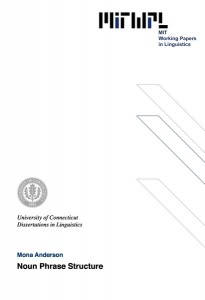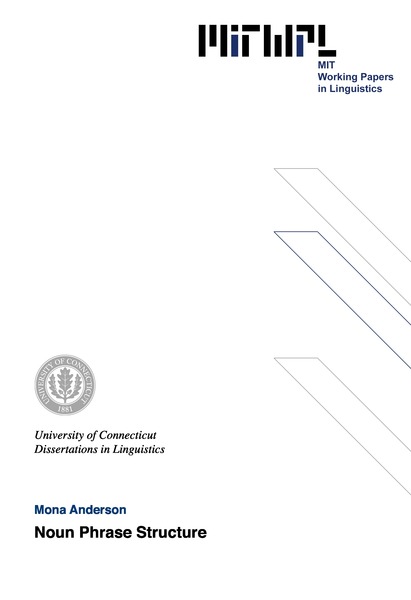Noun Phrase Structure
M. Anderson, 1979
Table of Contents
CHAPTER ONE
1.0 Introduction (1)
1.1 The Testability of the Lexicalist Hypothesis (3)
1.2 The Domain of Transformations (6)
1.3 The Lexicalist Hypothesis – Binding and Rules of Construal (6)
1.4 Lexicalist Hypothesis – Complements and Complementizers (8)
1.5 Gerundive Nominals (8)
1.51 Evidence for Different Structures (9)
1.52 Structure and Semantics of Action Nominals (11)
1.53 Unexplained Variation (14)
1.54 Derivation by Analogy (17)
1.55 An Alternative Analysis (19)
1.56 The Historical Facts (20)
1.57 Conclusion (21)
CHAPTER TWO
2.0 Introduction (23)
2.1 Apparent Restrictions on the Domain of Transformations (23)
2.11 Equi (23)
2.12 Dative Movement (24)
2.13 Particle Movement (27)
2.14 There Insertion (30)
2.2 A Suggested Principle for Restricting the Domain (33)
2.3 NP Preposing: Some Irregularities (34)
2.31 Rule Features to Mark Irregularities (35)
2.32 Restriction of Syntactic Frames (36)
2.33 Nominals Which Take for (40)
2.34 Nominals With of Which Dont Exhibit NP Preposing (42)
2.35 Emonds Analysis of NP Preposing (46)
2.351 Preposition Stranding (46)
2.352 Passive Morphemes (54)
2.353 NPS Without Subjects (54)
2.354 Preposing Adverbial NPs (55)
2.40 Raising (60)
2.41 Raising and the Lexicalist Hypothesis (61)
2.5 Conclusion (63)
CHAPTER THREE
3.0 Introduction (67)
3.1 Picture Nouns (67)
3.2 Reflexive (70)
3.21 Previous Treatments (71)
3.211 Harris (71)
3.212 Helke (72)
3.213 Jackendoff (73)
3.214 Chomsky (73)
3.22 Modification of Chomskys Bound Anaphora Rule (74)
3.221 Reflexive Rule Compared to Rule of Control (78)
3.222 The Control Rule Without the c-command Condition (79)
3.23 The Interaction of Binding Conditions with the Reflexive Rule (79)
3.231 Binding Conditions in NPs (81)
3.232 Predictions of the Revised System (81)
3.24 An Unsolved Problem (82)
3.25 The Proposed Analysis Compared with Jackendoffs (83)
3.3 Reciprocals (86)
3.4 Disjoint Reference (88)
3.41 Chomskys Rule (88)
3.42 Disjoint Reference and Reflexive in NPs (89)
3.43 Disjoint Reference Without the c-command Condition (91)
3.44 Possessive Pronouns (93)
3.45 A Possible Solution (93)
CHAPTER FOUR
4.0 Introduction (96)
4.1 The Complement System in Filters and Control (97)
4.2 The Complement System in On Binding (99)
4.3 Control and Complements in NPs (102)
4.4 Complementizers in Noun Complements (103)
4.5 Nouns Related to Verbs of Object Control (105)
4.6 Nouns Related to Verbs of Subject Control (106)
4.7 Nouns of Control in On Binding (107)
4.8 A Revision (110)
4.9 Comparing the Analyses (111)
4.10 A Problem in Common (113)
4.11 Comparison with Filters and Control (114)
4.12 Complementizer Choice for Nouns (116)
4.13 Distribution of Complements for Control Nouns (117)
4.14 For Prepositional Phrases in NPs (121)
4.15 Nouns with Defective Paradigms (125)
4.16 Subcategorization (131)
4.17 An Old Problem (139)
REFERENCES (146)
Abstract
This is a study of the internal structure of English complex noun phrases with lexical nouns as heads. The application of transformations within these NPs is compared to the application of transformations in parallel sentences. It is argued that no external restrictions on the application of transformations in NP and S are needed. General conditions on all transformations account for apparent exceptions. A semantic class of nouns is isolated which in the underlying forms takes a bare NP complement rather than a prepositional phrase complement. A general prohibition against preposition stranding is proposed.
The co-reference relations between full nouns, pronouns, reflexives, and reciprocals embedded in NPs are compared to co-reference relations between these elements when they are not so embedded. The condition that an antecedent must c-command its anaphor is found to be too restrictive and is replaced by a nearness condition involving kommand. It is claimed that in terms of anaphoric relations, picture nouns are not exceptional in comparison to other nouns.
It is argued that the sentential complement system for nouns, while it is related to that of verbs, differs in many respects. It is proposed that nouns and their sentential complements bear an appositive type of relationship to each other except in those cases when a true preposition mediates between them.

